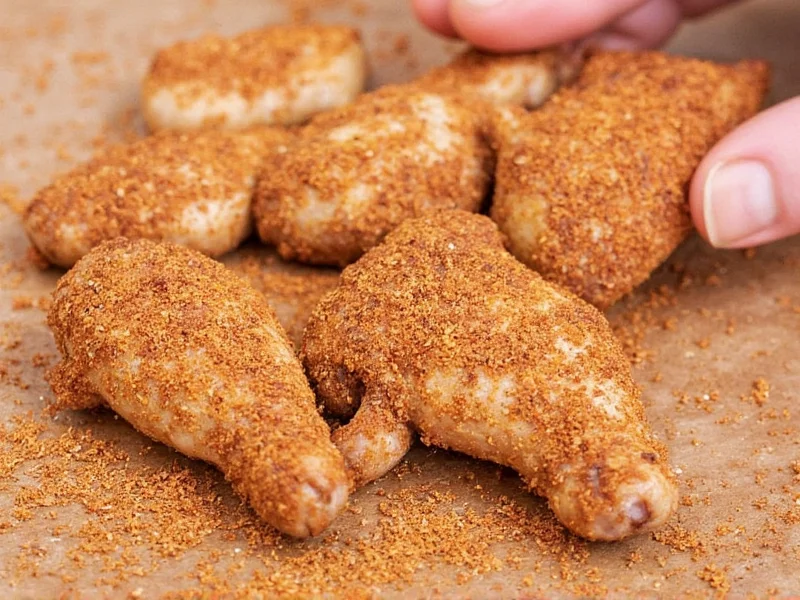The Essential Components of a Quality Chicken Seasoning Rub
Creating the perfect chicken seasoning rub starts with understanding the role each ingredient plays. Salt serves as the foundation, enhancing natural flavors and helping to form a desirable crust. Black pepper adds subtle heat and complexity. Garlic and onion powders provide savory depth without burning like fresh versions might. Paprika contributes both color and a mild sweetness, while dried herbs like thyme, rosemary, or oregano add aromatic notes that withstand high-heat cooking.
When crafting your homemade chicken seasoning rub recipe, consider the balance between salty, sweet, savory, and spicy elements. The ratio matters more than the specific ingredients—typically 4 parts salt to 2 parts sugar (if using) to 1 part other spices creates a balanced foundation. For those seeking a chicken seasoning rub without salt, increase herbs and spices proportionally while adding a touch more sugar to maintain flavor balance.
Creating Your Own Custom Chicken Rub
Developing your signature dry rub for grilled chicken allows customization for personal taste preferences. Start with this basic ratio for a versatile all-purpose rub:
| Flavor Profile | Key Ingredients | Best Cooking Method |
|---|---|---|
| Classic All-Purpose | Salt, pepper, garlic powder, onion powder, paprika, thyme | Roasting, grilling, baking |
| Spicy Southwest | Chili powder, cumin, smoked paprika, cayenne, oregano | Grilling, smoking |
| Herb-Forward | Rosemary, thyme, sage, garlic powder, lemon zest | Roasting, sous vide |
| Sweet & Smoky | Brown sugar, smoked paprika, cumin, cinnamon, cayenne | Smoking, grilling |
Application Techniques for Maximum Flavor
Proper application makes all the difference in your chicken rub for baking or grilling. First, pat chicken completely dry with paper towels—moisture prevents proper adhesion. Next, apply a thin layer of neutral oil (like canola or avocado) to help the rub stick. Then generously coat all surfaces, pressing the mixture gently into the meat.
For optimal flavor development, let the seasoned chicken rest before cooking. The ideal resting time depends on the cut: boneless breasts need 30-60 minutes, while whole chickens or bone-in pieces benefit from 2-4 hours in the refrigerator. This allows flavors to penetrate while the salt begins breaking down proteins for more tender results. Never leave a sugar-based rub on for more than 4 hours at room temperature, as it can start breaking down the meat's texture.
Avoiding Common Seasoning Rub Mistakes
Many home cooks make critical errors when using chicken seasoning mix ingredients. The most frequent mistake is applying too little rub—be generous, as some will fall off during cooking. Another common issue is adding liquid ingredients to dry rubs, which creates a paste that burns easily. If you want moisture, apply oil first, then the dry rub.
Don't forget to season both sides of chicken pieces evenly, including underneath. When cooking skin-on chicken, gently lift the skin and apply some rub directly to the meat for deeper flavor penetration. For the best results with your dry rub for grilled chicken, avoid flipping too frequently—let that flavorful crust develop properly before turning.
Storage and Shelf Life of Homemade Rubs
Store your homemade chicken seasoning rub recipe in an airtight container away from light and heat. Properly stored, most dry rubs maintain peak flavor for 3-6 months. Label containers with the date made, as potency diminishes over time. For extended shelf life, keep rubs containing sugar in the refrigerator to prevent clumping.
Revive older rubs by adding a pinch of fresh spices. If your rub has been stored longer than six months, do a smell test—discarded if the aroma has faded significantly. Never store rubs in containers that previously held strong-smelling foods, as spices readily absorb surrounding odors.
Adapting Rubs for Different Cooking Methods
The ideal chicken rub for baking differs slightly from one designed for grilling. For oven cooking, you can include more delicate herbs like basil or tarragon that might burn on the grill. When preparing rubs specifically for smoking, increase smoky elements like smoked paprika to complement the cooking method.
For sous vide preparation, reduce salt content by about 25% since the vacuum-sealed environment intensifies seasoning. When using your rub for air frying, minimize sugar content to prevent excessive browning at high temperatures. Understanding these nuances ensures perfect results regardless of your chosen cooking technique.











 浙公网安备
33010002000092号
浙公网安备
33010002000092号 浙B2-20120091-4
浙B2-20120091-4